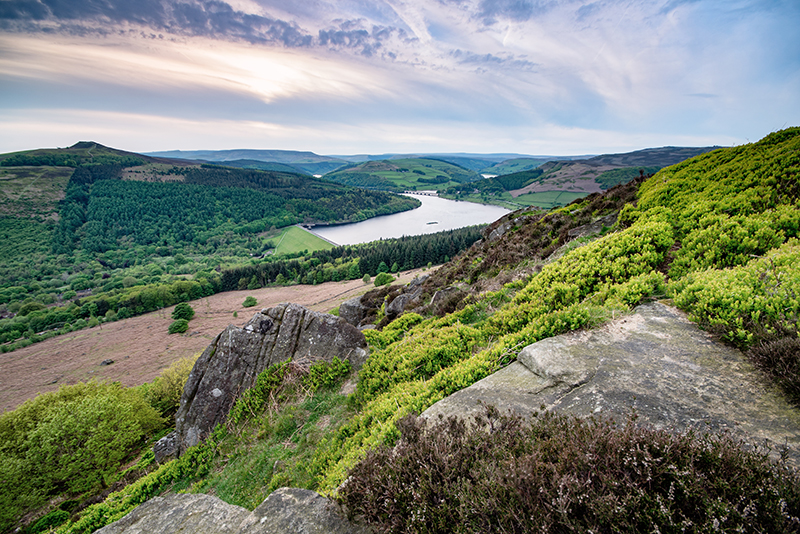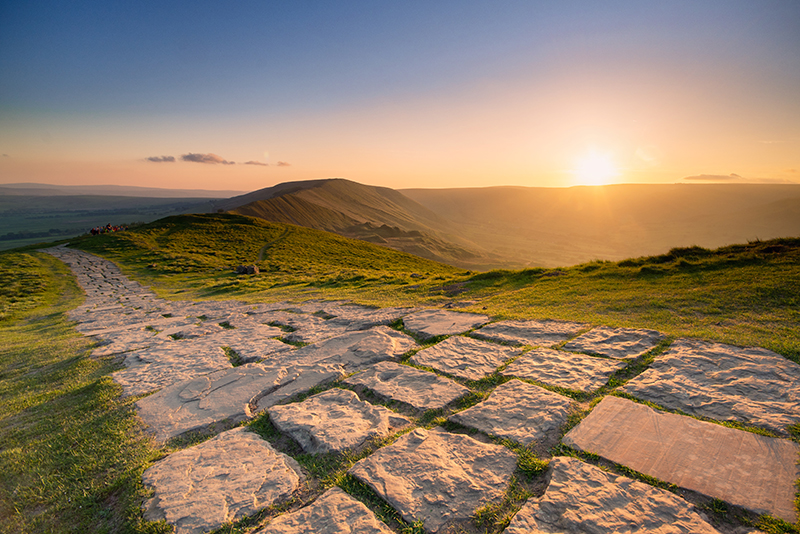
The mountain range that stretches from Albania to Kosovo and Montenegro has a name that translates into both Albanian and Serbian as “the Accursed Mountains.” The grand peak in the Italian Alps, not far from the French border, gets the five-star-resort moniker Gran Paradiso. The ancient Greeks, of course, named their highest peak Olympus – you need something that sounds good for the place where all your gods live.
But all that lyrical waxing is for the south. At the opposite corner of Europe, on that island nation of Anglo-Saxon plain-spokenness, they don’t go for such carrying on. In England, if you’ve got a district with a bunch of peaks in it, there’s no need to make things complicated.
Welcome to the Peak District.
The Peak District – which sits smack in the middle of England, mostly in the Midlands county of Derbyshire – offers one of England’s most beautiful and varied tourist experiences. That more Americans don’t visit it likely has to do with its distance from London. It’s not far – nothing in this geographically compact country is very particularly far. (From London St. Pancras rail station, you can be standing in the middle of the Peak District in not much more than three hours.) There are just other rural destinations closer to London, where the vast bulk of US-to-UK flights land. And look, nobody’s saying the Cotswolds aren’t lovely. But the Peak District is worth that extra little bit of time on the train.
Within the Peak District lie two distinct areas. The northern Dark Peak offers a similar wild and desolate look to that of the nearby Yorkshire Moors; atop hills, trees give way to moorland and peat bogs. To the south, the White Peak’s hills have the lush, green, forested look more commonly associated with the English countryside. In both places, you’ll find plenty of well-worn hiking trails snaking through tiny villages that look untouched from previous centuries – as long as you ignore the fancy cars and SUVs barreling through them. (Pristine Peak District villages make popular upmarket commuter homes for nearby cities.)
To get the most out of a Peak District vacation, it’s best to bring a sturdy pair of walking shoes. (And a waterproof jacket. This is England after all; that sunny day may yet betray you.) For hiking help, you could fill a library with Peak District hike guidebooks. (And if you don’t order some beforehand, villages that hikers frequent will invariably have at least one shop selling some.) One guidebook author who’s always good about including hikes with varied difficulties and points of interest is Mark Reid. His books are found at innway.co.uk and include easy narrative descriptions for hikers who might not be comfortable with a compass and an OS map.
One of the most popular hike jumping-off points is the village of Edale. Pronounced with a long “e” so that it rhymes with “sea,” the village sits in the Hope Valley, which separates the White and Dark Peak. Edale marks the start of the Pennine Way, a 267-mile ramble that ends just inside Scotland. If that sounds a tad ambitious, local hikes to the peak of Mam Tor or the moorland plateau of Kinder Scout offer spectacular views. Just outside the nearby village of Castleton, you can tour the Blue John Cavern, which gets its name from the mineral mined there which is used in jewelry. Edale also benefits from two excellent pubs, the atmospheric, dating-to-1577 Nag’s Head, and the Rambler Inn, which has a massive beer garden to one side and rooms to rent upstairs.
Eyam (Pronounced to rhyme with “cream”) is another popular village surrounded by great hikes. It’s known as “the plague village” and as you might expect, there’s a bit of a story behind the nickname. When the bubonic plague outbreak hit the village in the 1660s, villagers took the remarkable step of quarantining themselves in their own village to prevent it spreading farther. The Earl of Devonshire, from his nearby home at the great manor house Chatsworth, was nice enough to offer to send food and supplies if the villagers stayed quarantined. So at least there was that. Chatsworth House today is one of the Peak District’s biggest tourist attractions; on summer days, the house and expansive gardens fill with visitors.
The White Peak offers several larger towns including Matlock Bath, a popular tourist destination since the 19th century. Victorian tourists flocked to the healing properties of its mineral spas; today’s visitors are more likely to seek out its inexpensive, family-friendly tourist attractions. The Peak District Lead Mining Museum offers insight into the region’s formerly crucial industry – and gives kids an idea of how lucky they are to live in a time of child labor laws. If you prefer to attain the summit of a Peak District peak without the hike, the Heights of Abraham tourist attraction operates cable cars over the Derwent Valley and up to the top of Masson Hill.
Not far from Matlock Bath, the village of Cromford offers a real treat for bibliophiles. Scarthin Books is a rambling old independent bookstore with several bookstore cats, a properly English café and book-filled nooks and crannies everywhere. Old-fashioned train enthusiasts might also want to check out Peak Rail. The heritage railway, which runs several steam engines and vintage UK passenger cars, runs from Matlock station to several villages and stops through scenery that inevitably stuns. Trains don’t run every day, so it’s best to check peakrail.co.uk first.
Old steam trains aren’t the only form of public transport that works in the Peak District. A rental car really isn’t necessary; several train lines and many buses traverse the region. The most easily accessed train line is the Hope Valley Line, which includes Edale on its route. It crosses the Peak on a route between the major metropolis of Manchester and the mid-sized city of Sheffield. Actually, if you want your Peak District trip to also include a bit of urbanity, it’s possible to stay in either city center, catch a train, and be standing on a rural hillside within the hour. Manchester’s a thriving, sprawling place – urbane and filled with great dining, arts and culture, but also proud of its working-class, industrial heritage. (American comparison? Think Chicago to London’s New York.) It’s also got the world’s most popular soccer team, Manchester United – although in recent years, crosstown rival Manchester City’s been notching more victories.
But for nearby urbane fun, you’d also do well to look to the other side of the Peak District and Sheffield. Historically associated with the steel industry – laid-off-steelworkers-turned-strippers film The Full Monty was set here – it’s in more recent years had an arts and culture renaissance. The Crucible is one of Britain’s best producing theaters outside London, while the city’s music scene is also considered one of Britain’s best – this is, after all, the city that produced both Jarvis Cocker and the Arctic Monkeys.
But if you prefer your country sojourn without any city interference, you won’t struggle to find a place to stay in the Peak District. Several of the larger towns offer chain hotels, but for a real Peak experience, try one of the many village B&Bs. Or for a real adventure – in a weather-appropriate time of year – plop a tent down in one of the region’s many campgrounds.
The name “Peak District” may underwhelm, but it does offer so much to those willing to seek it out. History, scenery and culture, all capped off by a pint of ale and a proper pub dinner – it’s a kind of paradiso, even if the locals won’t call it that.














